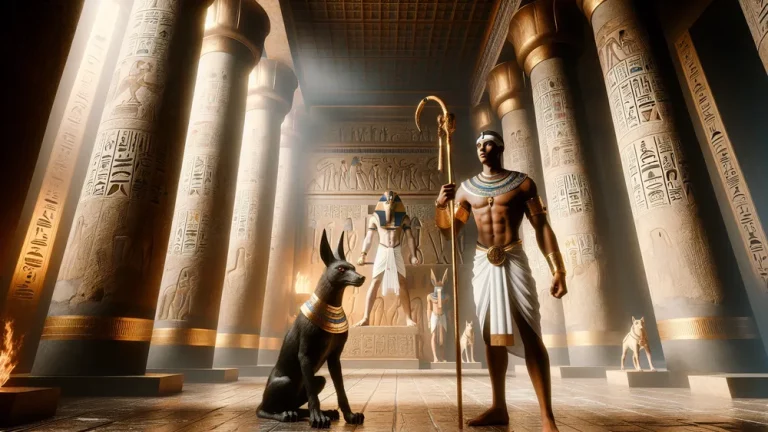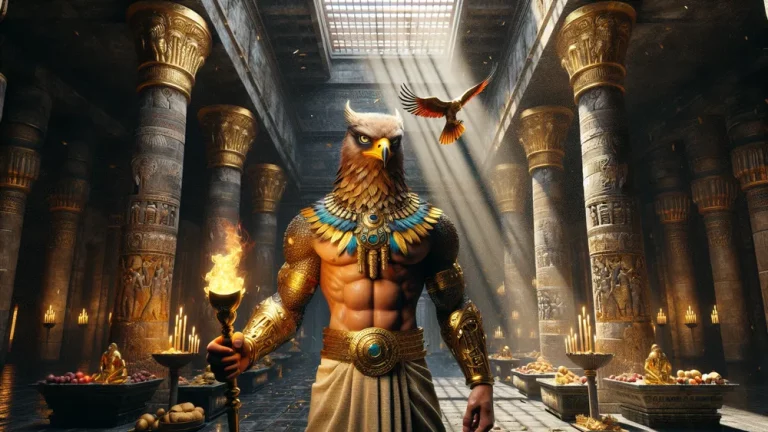Hercules And The Nemean Lion: The Indestructible Beast
The story of Hercules and the Nemean Lion is one of the more lasting stories in Greek mythology, showing off ideas of strength and bravery and how smart thinking can win over just being strong. Hercules, also called Heracles in Greek myths, was given twelve big tasks to do, and the first one had him going up against the tough Nemean Lion.
Key Points:
- The Nemean Lion is a creature from Greek myths, known for its tough skin that can’t be hurt by regular weapons.
- Hercules had to defeat this lion as part of his Twelve Labors, relying on both strength and clever tactics.
- The lion was said to be the offspring of Typhon and Echidna, adding to its legendary fearsome nature.
- After defeating the lion, Hercules used its skin as a nearly impenetrable cloak.
- The story means important Greek values such as bravery, strength, and being smart.
- Art heavily featured the tale, especially in ancient pottery and sculptures showing the legendary fight.
- The Nemean Lion’s tale still influences stories today, embodying overcoming huge challenges.
When you explore this, think about the lion as not just a scary animal but something that stands for different myths and ideas from culture. The story of the Nemean Lion is a sign of how complex Greek myths can be, where beings have exciting family backgrounds and need heroes not just to be strong but smart.
Seeing the lion’s story as part of a bigger group of tales helps us appreciate how it has shaped art, culture, and values in old Greek life. While we look deeper into this famous meeting, we will look at where the lion came from, its amazing traits, and how it fits into a bigger story – all of which add more depth to a story that’s already full of it.
Nemean Lion: Overview and Key Facts
| Aspect | Key Details |
|---|---|
| Origin | People usually think the Nemean Lion was the child of the huge Typhon and Echidna, though some stories say it might have come from Selene or Zeus. |
| Habitat | For the lion, its home was in Nemea, getting its name this way, and folks said it lived in a cave with two openings. |
| Unique Characteristics | Its skin couldn’t be pierced by normal weapons, giving it almost can’t-be-beaten strength, which made it a very strong opponent. |
| Mythological Significance | As Hercules’ first big job, the lion was not just a real problem but also meant a step towards him becoming a big hero in myths. |
| Defeat by Hercules | Hercules had to change his methods, finally squeezing it to win because the lion’s tough skin, which means being smart in a power fight. |
| Symbolism in Greek Culture | Strong, brave fighting meant by the lion in Greek culture, often seen in art and stories as something really wild and tough. |
| Legacy | The Nemean Lion’s skin, after it was beaten, was worn by Hercules and meant his strength and hero status, seen in lots of later art and writing. |
| Representation in Art | A lot in old pots, floor pictures, and statues, the lion’s pictures became usual in Greek art of stories. |
Where Did the Nemean Lion Come From?
To know where the Nemean Lion began gives us interesting ideas about its place in myths and its strong power, which nobody could match. Let’s look into the powerful family background of this beast, which can’t be beaten, and find out how who it came from gave it its feared traits.
Parents and Birth
The Nemean Lion, known as a tough beast in Greek stories, is most often said to come from Typhon and Echidna, famous characters that mean chaos and frightening things. Typhon, a giant storm god that had a frightening look, and Echidna, who was half woman, half snake, were well-known for their scary kids, like the Nemean Lion and others.
This background gave the lion its special traits like being really strong and nearly impossible to defeat. But mythology often tells varied family stories and also says the lion might be a child of Zeus or Selene, which adds more to its story. Thinking today, the lion’s background could seem like getting the strongest parts from both sides of a family, making it stand out with unmatched qualities.
This tells about how myths explained ideas of passed-down strength and great challenges from gods. By knowing these basic things, we learn why the Nemean Lion was so feared in old myths.

The Nemean Lion, feared for its unbeatable strength in Greek myths, often comes from Typhon and Echidna, but other stories also say Zeus or Selene, showing how myths talk about passed-down strength and mighty challenges.
The Nemean Lion: What Made It Special
Now you know where the Nemean Lion started, it’s time to look closer at the special features separating this lion from other normal animals in Greek stories.
Really Tough Skin and Unmatched Power
The Nemean Lion had the most amazing thing: its tough skin, which meant it could not be hurt in fights. Stories say its skin was so tough that no human tools could get through it. Think about the lion wearing old-timey armor that stops bullets. This idea means it was a big scary thing for anyone trying to beat it.
Because of this, just using force wasn’t going to work; people had to think of new ways. While not every story talks about where this special skin came from, it is always a big part of what made the lion known.
Besides its strong defense, the Nemean Lion had incredible physical strength. It used this power not just in fights but to scare people living near Nemea, showing it as a fearsome beast not only due to its being hard to break but also because of how strong it was. Think of the lion as a force that can’t be stopped, like the strongest animals today, but made bigger with myth tales. Major points of its big power were:
- Huge physical power letting it beat anyone.
- Great fierceness making it a scary problem.
- Strong force leading many to run away for safety.
These points made things hard for anyone brave enough to take on the lion, making it one of the most feared creatures in Greek tales.
Deeper Meaning in Myths
In myths, the Nemean Lion means more than just being unbeatable; it is a story of the dangerous tests that heroes face. These stories tell about the lion’s tough skin and basic strength, which mean big problems that need smart thinking and bravery to beat. Think about these tales as the first stories about “getting through the impossible,” a theme we still see now in books and movies where main characters face really hard enemies, not just with power, but by being clever and not giving up. The lion also tells about the hero’s growth from being scared to being in control, helping people see why such stories still matter. Key points that the Nemean Lion shows in these stories are:
- Being an unbeatable challenge, pushing heroes to think hard and be smart.
- Standing for wild nature, which means how people try to deal with chaos.
- Explaining ancient ideas like bravery and planning when things get tough.
These ideas from the Nemean Lion’s stories still mean a lot in cultures today, linking old and new ideas of what it means to be a hero.

The Story of Hercules Taking on the Nemean Lion
After looking at the strong nature and the meaning of the Nemean Lion, now let’s see the famous story where Hercules had to face this well-known creature, which was part of his heroic tasks.
Hercules’ Big Task: An Epic Showdown
When Hercules met the Nemean Lion, it became a well-known story in Greek myths, showing a fight where brains and muscles both mattered. Told to kill the lion as his first large challenge in the Twelve Labors, Hercules went to Nemea. He soon found out regular weapons, like arrows and a spear, did not work, as they hit the lion’s skin and just bounced off.
This brought him to understand he needed to use his great strength and clever ideas – a clear example that heroes needed more than just being strong to succeed in the tales of Greek mythology. If you consider modern problems, think about this as being similar to a puzzle where normal answers are no good, so you must think differently.
Hercules realized traditional ways wouldn’t work, so he thought of a new plan. In some stories, Hercules caught the lion in its own cave. He blocked an entrance and took it on directly. Using his incredible power, he wrestled and finally strangled the lion, which proved how heroes were expected to use cleverness together with brute force.

Here are some important moments in this epic battle:
- Understanding the lion was hard to hurt.
- Deciding to fight the lion in its cave.
- Hercules used strong force and skills in close fighting.
These moments make clear Hercules’ amazing skills and how the story meant that cleverness can be as important as power when facing what seems unbeatable.
Winning with Smarts
In myths, Hercules meant the smart planning that heroes had, especially in his fight with the Nemean Lion. He knew plain force and normal tools did not work on the lion’s tough skin. It means you can see how changing tactics could meet the challenge. In some stories, Hercules, by shutting one of the cave doors, trapped the lion inside.
This way, he stopped the lion from getting out or using all its power. He was in control of the fight place. So, this move is like in a game where you put the other player in a tight spot where how you handle the space can win it all. Plus, Hercules mixed planning with his skill.
Once the lion was stuck in the cave, he fought it directly. He used his strong power to wrestle the lion and beat it. This means that in Greek heroes, they don’t just need to be strong but also smart in their way of thinking.
People now can see this story as meaning how to deal with hard problems by being patient, planning, and thinking smart. This mix of brain and force is a usual idea in what Hercules did, showing why he is known as not just a strong fighter but a smart one too.
What Happened After the Fight
After Hercules beat the tough Nemean Lion using smart plans, it’s only natural that people start to wonder about how this win turned into more amazing tales.
Change and What Came Next
After taking down the tough Nemean Lion, Hercules’ next move was both useful and meaningful – he skinned the beast to make a cloak that couldn’t be hurt. It was no small thing, considering the hide that pushed away weapons was not easy to cut with any regular tools. As different stories tell, either he used the lion’s claws for this job or got help from the gods, which means these stories have many angles.
The cloak started meaning power, showing Hercules’ new strength and growing place as a hero who could do the impossible. If we think about today, it’s like a hero getting a legendary item making them almost unbeatable, pointing to Hercules’ first big job’s changing nature.

This special cloak was with him in his next adventures, adding to the story of his rise from a man to a legend among the gods.
Hercules skinned the Nemean Lion to make a special, indestructible cloak that showed his growing strength and status as a hero.
The Lion’s Influence and Long-term Effect
When people heard the story of Hercules and the Nemean Lion, its impact stayed way beyond just the fight’s end. It made a lasting impact on culture and art through the years.
How Artists Have Shown It Over Time
Starting in ancient Greece, the story of Hercules and the Nemean Lion has been a popular topic for artists. And this means it’s great for seeing how art styles and what people like have changed. In Greece long ago, they put this scene on pottery and sculptures. They focused on Hercules’ strength and how fierce the lion was. These pictures were not only for decorating.
They helped tell stories of bravery and being a hero to people who learned myths through art and spoken word. When art moved into the Renaissance, people like Peter Paul Rubens made the scene lively again with dramatic setups and bright colors that showed strong feelings. This reflected how interested people were in how bodies worked and in storytelling. Today, artists use digital ways and art shows.
They put Hercules and the lion there to show how new technology and stories change old myths.
This ongoing interest is clear because of all the different types of art and situations that put forward the myth. They range from decorative and formal to more personal art. Here is a summary of how pictures of Hercules and the Nemean Lion have changed:
| Time Period | Medium | Key Features |
|---|---|---|
| Ancient Greece | Pottery, Sculpture | Focus on physical effort and hero ideas |
| Renaissance | Paintings | Focus on dramatic setups and showing feelings |
| 19th Century | Neoclassical Art | Return to balance and ideal forms |
| Modern Era | Digital, Installation | Mixed media and new context interpretation |
This assortment of art forms not only means the tale stays likable through time but also that it changes to match new likes and art methods in each era. Through these art pieces, Hercules’ fight with the Nemean Lion keeps sparking interest, making people think and feel inspired across different times.
What It Stood For in Ancient Greek Life
The story of Hercules and the Nemean Lion in ancient Greek life was more than just a story. It became a strong sign of resilience, bravery, and challenges between people and nature’s tough tests.
Like today’s tales which sometimes teach us lessons or reveal what society values, this story meant key Greek values such as courage, strength, and using smarts where just strength doesn’t work. For Greeks, Hercules was the perfect hero – an example of power whose hard tasks meant life’s problems and how you could overcome them. This story gave a cultural touchstone.
The strong lion was nature’s hard problems, and by winning, Hercules gave people hope about human power and help from above. Myths weren’t just for fun but were part of everyday life and the rules of culture, just like how stories today can shape what we do and think, guiding people both in private life and society.
A Look at Greek Mythical Creatures and Monsters
Greek myths have lots of different creatures and monsters. Each one means something and often represents human feelings or the wild parts of the world. These beings include giants like the Cyclops, known for their great strength and having one eye, and the smart but dangerous hydra, a snake-like creature whose heads would grow back double when cut.
Each creature is part of the rich stories in Greek myths. They mean things like chaos or strength and can be protectors or wise figures. Many of these beings have become symbols in stories where gods and heroes meet challenges, playing roles as bad guys or signs of beating life’s problems.
For more, you can look at this Greek Creatures and Monsters list, which offers a big look at these mythical beings and their ongoing mark on stories.
FAQs
1. How did the Nemean Lion become invincible?
The Nemean Lion became invincible through its supernatural origins, being born from the fierce monsters Typhon and Echidna, which endowed it with impenetrable skin.
2. What did Hercules do with the Nemean Lion’s hide?
Hercules used the Nemean Lion’s hide as a nearly invincible armor.
3. How is the Nemean Lion’s story depicted in ancient art?
The Nemean Lion’s story is depicted in ancient art primarily through intricate pottery and sculptures that highlight Hercules’ battle and triumphant victory over the beast.
4. Are there similar Greek myths involving invincible creatures?
Yes, there are similar Greek myths involving invincible creatures, such as the Hydra with its regenerative heads and the Chimera with its formidable defenses.







